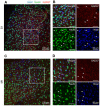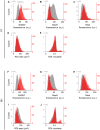Deep Learning-Based Classification of GAD67-Positive Neurons Without the Immunosignal
- PMID: 33867947
- PMCID: PMC8044854
- DOI: 10.3389/fnana.2021.643067
Deep Learning-Based Classification of GAD67-Positive Neurons Without the Immunosignal
Abstract
Excitatory neurons and GABAergic interneurons constitute neural circuits and play important roles in information processing. In certain brain regions, such as the neocortex and the hippocampus, there are fewer interneurons than excitatory neurons. Interneurons have been quantified via immunohistochemistry, for example, for GAD67, an isoform of glutamic acid decarboxylase. Additionally, the expression level of other proteins varies among cell types. For example, NeuN, a commonly used marker protein for postmitotic neurons, is expressed differently across brain regions and cell classes. Thus, we asked whether GAD67-immunopositive neurons can be detected using the immunofluorescence signals of NeuN and the fluorescence signals of Nissl substances. To address this question, we stained neurons in layers 2/3 of the primary somatosensory cortex (S1) and the primary motor cortex (M1) of mice and manually labeled the neurons as either cell type using GAD67 immunosignals. We then sought to detect GAD67-positive neurons without GAD67 immunosignals using a custom-made deep learning-based algorithm. Using this deep learning-based model, we succeeded in the binary classification of the neurons using Nissl and NeuN signals without referring to the GAD67 signals. Furthermore, we confirmed that our deep learning-based method surpassed classic machine-learning methods in terms of binary classification performance. Combined with the visualization of the hidden layer of our deep learning algorithm, our model provides a new platform for identifying unbiased criteria for cell-type classification.
Keywords: GAD67; NeuN; deep learning; fully convolutional network; interneuron; motor cortex; mouse; somatosensory cortex.
Copyright © 2021 Yamashiro, Liu, Matsumoto and Ikegaya.
Conflict of interest statement
The authors declare that the research was conducted in the absence of any commercial or financial relationships that could be construed as a potential conflict of interest.
Figures








Similar articles
-
Characterization and quantification of isoflurane-induced developmental apoptotic cell death in mouse cerebral cortex.Anesth Analg. 2013 Apr;116(4):845-54. doi: 10.1213/ANE.0b013e318281e988. Epub 2013 Mar 4. Anesth Analg. 2013. PMID: 23460572
-
Preprodynorphin-expressing neurons constitute a large subgroup of somatostatin-expressing GABAergic interneurons in the mouse neocortex.J Comp Neurol. 2014 May 1;522(7):1506-26. doi: 10.1002/cne.23477. J Comp Neurol. 2014. PMID: 24122731
-
Green fluorescent protein expression and colocalization with calretinin, parvalbumin, and somatostatin in the GAD67-GFP knock-in mouse.J Comp Neurol. 2003 Dec 1;467(1):60-79. doi: 10.1002/cne.10905. J Comp Neurol. 2003. PMID: 14574680
-
Immunofluorescently labeling glutamic acid decarboxylase 65 coupled with confocal imaging for identifying GABAergic somata in the rat dentate gyrus-A comparison with labeling glutamic acid decarboxylase 67.J Chem Neuroanat. 2014 Nov;61-62:51-63. doi: 10.1016/j.jchemneu.2014.07.002. Epub 2014 Jul 21. J Chem Neuroanat. 2014. PMID: 25058170
-
Contribution of parvalbumin and somatostatin-expressing GABAergic neurons to slow oscillations and the balance in beta-gamma oscillations across cortical layers.Front Neural Circuits. 2015 Feb 3;9:6. doi: 10.3389/fncir.2015.00006. eCollection 2015. Front Neural Circuits. 2015. PMID: 25691859 Free PMC article.
Cited by
-
Deep-learning based breast cancer detection for cross-staining histopathology images.Heliyon. 2023 Jan 21;9(2):e13171. doi: 10.1016/j.heliyon.2023.e13171. eCollection 2023 Feb. Heliyon. 2023. PMID: 36755605 Free PMC article.
-
Machine learning-based segmentation of the rodent hippocampal CA2 area from Nissl-stained sections.Front Neuroanat. 2023 Jun 28;17:1172512. doi: 10.3389/fnana.2023.1172512. eCollection 2023. Front Neuroanat. 2023. PMID: 37449243 Free PMC article.
-
Interpretable Classification of Tauopathies with a Convolutional Neural Network Pipeline Using Transfer Learning and Validation against Post-Mortem Clinical Cases of Alzheimer's Disease and Progressive Supranuclear Palsy.Curr Issues Mol Biol. 2022 Nov 29;44(12):5963-5985. doi: 10.3390/cimb44120406. Curr Issues Mol Biol. 2022. PMID: 36547067 Free PMC article.
-
Prenatal 1-Nitropyrene Exposure Causes Autism-Like Behavior Partially by Altering DNA Hydroxymethylation in Developing Brain.Adv Sci (Weinh). 2024 Jul;11(28):e2306294. doi: 10.1002/advs.202306294. Epub 2024 May 16. Adv Sci (Weinh). 2024. PMID: 38757379 Free PMC article.
References
LinkOut - more resources
Full Text Sources
Other Literature Sources

